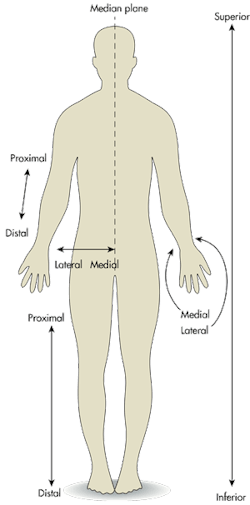Medial and lateral: Medial refers to being toward the midline of the body or the median plane, which splits the body, head-to-toe, into two halves, the left and right. Lateral is the side of the body or part of the body that is away from the middle. So arms are lateral to the torso while the torso is medial to the arms. And the medial side of the knee is the inside part or side nearest to the other knee, while the lateral side of the knee faces away from the center of the body and is farthest from the other knee.
Ipsilateral refers to things on the same side of the body, the right or the left as defined by the median plane. So a person’s left arm and leg are ipsilateral. And if a person had a rash only on the right side of his torso and head, the rash would be ipsilateral. The spleen and descending colon, both on the left side of a body, are also ipsilateral. Contralateral refers to things on opposite sides of the median plane. That makes a person’s arms contralateral as well as his legs, ears, and lungs.
Proximal and distal: These two terms are almost always used in reference to relative locations of parts or places on the limbs. Proximal then refers to something closer to the torso while distal refers to parts and places away from the torso. So a finger is distal to the wrist, which is distal to the elbow, which is distal to the shoulder. Or, similarly, the femur is proximal to the knee, which is proximal to the ankle, which is proximal to the toes.
Superior and inferior: These terms reference the body’s vertical axis, and a body part higher than another or above it is said to be superior to it; conversely, the other body part is inferior to the first. So the head is superior to the neck, the neck is superior to the torso, and the torso is superior to the legs.


